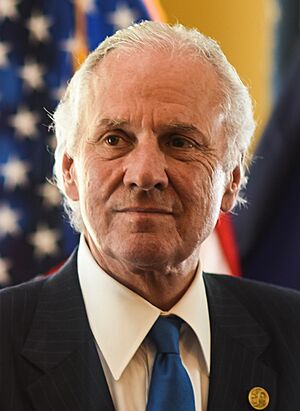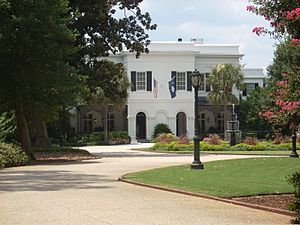Governor of South Carolina facts for kids
Quick facts for kids Governor of South Carolina |
|
|---|---|

|
|

|
|
| Government of South Carolina | |
| Style | His Excellency |
| Residence | Governors Mansion |
| Seat | Columbia |
| Appointer | Elected at-large |
| Term length | Four years, renewable once consecutively |
| Constituting instrument | Constitution of South Carolina |
| Inaugural holder | William Sayle |
| Formation | March 15, 1670 |
| Succession | Line of succession |
| Deputy | Lieutenant Governor of South Carolina |
| Salary | $106,078 (2022) |

The governor of South Carolina is the main leader of the state government in South Carolina. Think of them as the chief executive, like a president for the state. The governor is also the top commander of the South Carolina National Guard when it's not working for the national government.
The governor has many important jobs. They give a "State of the State" speech each year to the state's lawmakers. They also suggest a budget for how the state should spend its money. Most importantly, they make sure that all state laws are followed.
The current governor of South Carolina is Henry McMaster. He is the 117th person to hold this job. He became governor on January 24, 2017. This happened after the previous governor, Nikki Haley, left to become a United States ambassador. Governor McMaster has won two elections since then. He is also the longest-serving governor in South Carolina's history.
Contents
Becoming Governor: What You Need to Know
To become governor of South Carolina, a person must meet a few requirements. These rules are written in the state's Constitution.
Age and Residency Rules
First, a candidate must be at least 30 years old. Second, they must be a citizen of the United States. They also need to have lived in South Carolina for at least five years before the election day.
Old Religious Rule
There is an old rule that says a person cannot be governor if they "deny the existence of the Supreme Being." However, the United States Supreme Court decided in 1961 that religious tests for public jobs are not allowed. Even though this old rule is still in the South Carolina Constitution, it is not considered valid today.
How Long Does a Governor Serve?
A governor in South Carolina serves a four-year term. Their term starts at noon on the first Wednesday after the second Tuesday in January, following their election.
Term Limits
A person can be elected governor for two terms in a row. This means they can serve for eight years straight. However, there is no limit on how many total terms a person can serve in their lifetime. They just can't serve more than two terms in a row. For example, Olin D. Johnston served non-consecutive terms, meaning he was governor, left office, and then became governor again later.
What Does the Governor Do?
The governor of South Carolina has many important powers and duties. They are in charge of the state's executive branch.
Key Responsibilities
- They lead the state's executive branch.
- They choose leaders for 14 different state agencies. However, many of these choices need to be approved by the state's General Assembly (lawmakers).
- They are the commander of the South Carolina National Guard.
- They also lead the South Carolina State Guard, which helps with homeland defense within the state.
- They can change a death sentence to life imprisonment.
- They can call the General Assembly together for special meetings if there are very important issues.
- They can pause or end the General Assembly's meetings.
- They can reject bills (proposed laws) passed by the General Assembly. They can even reject specific parts of a spending bill.
- They can declare a state of emergency during disasters like hurricanes or floods. They also manage relief efforts.
- They can close public schools and government offices during emergencies.
- They oversee all state departments.
- They lead the boards of trustees for all state universities.
- They present a plan for the state's budget to the General Assembly every January.
- They give a "State of the State" speech to the General Assembly, usually in January.
- If a United States Senate seat becomes empty, the governor can appoint someone to fill it until the next election.
- They can appoint or remove county sheriffs if there's a vacancy or if they are not doing their job well.
- They can remove elected school board members for serious reasons, like not doing their job, conflicts of interest, or being medically unable to serve.
The governor is also part of the State Fiscal Accountability Authority. This group helps manage state spending and property.
Who Takes Over if the Governor Can't Serve?
If the governor cannot do their job, there is a clear line of succession. This means certain people are next in line to take over.
Order of Succession
- 1. Lieutenant Governor (currently Pamela Evette)
- 2. President of the South Carolina Senate (currently Thomas C. Alexander)
- 3. Speaker of the South Carolina House of Representatives (currently Murrell Smith)
If these three positions are all empty, other state officials can serve as an emergency interim governor. These include the Secretary of State, Treasurer, and Attorney General.
If the governor is temporarily unable to serve, the lieutenant governor takes on the governor's powers. This happened in 2014 when Lieutenant Governor Yancey McGill acted as governor while Nikki Haley had surgery.
No governor in South Carolina has ever been removed from office by impeachment. However, since 1776, ten governors have resigned. Four governors have died while in office. One governor, Andrew Gordon Magrath, was removed by the Union Army in 1865 at the end of the Civil War.
The Governor's Official Oath
Before taking office, the governor must say an oath. This is a promise to do their job well and protect the state and U.S. Constitutions. The oath is:
"I do solemnly swear (or affirm) that I am duly qualified, according to the Constitution of this State, to exercise the duties of the office to which I have been elected, (or appointed), and that I will, to the best of my ability, discharge the duties thereof, and preserve, protect, and defend the Constitution of this State and of the United States. So help me God."
A Look Back: History of South Carolina Governors
The role of governor in South Carolina has changed a lot over time.
Early Governors (1670-1719)
In the very early days, from 1670 to 1719, governors were chosen by the "Proprietors." These were the people who owned the land in the colony. Governors did not serve for a set amount of time.
Royal Governors (1719-1776)
Later, during the "Royal period," the British King or Queen appointed governors. These governors acted like representatives of the British monarch. They had a lot of power, including appointing officials and rejecting laws. They also served for no fixed term.
After the American Revolution (1776-1792)
After the American Revolution, from 1776 to 1779, the leader of South Carolina was called the "President." The state's lawmakers chose this person. John Rutledge and Rawlins Lowndes were the only two to hold this title. After 1779, the title changed back to "Governor."
Governors from 1790 to the Civil War
Under the Constitution of 1790, the General Assembly continued to choose governors. They served two-year terms and could not serve two terms in a row. This system changed after the American Civil War when the Union army took over.
After the Civil War (1865-Present)
James Lawrence Orr was the first governor chosen by popular vote, meaning the people voted for him. After the Civil War, there were big changes. All men over 21, no matter their race, were given the right to vote. The governor could then be elected for two terms in a row.
Later, in 1890, Benjamin Tillman became governor. This led to a new state constitution in 1895. This constitution made it harder for Black citizens to vote by requiring a poll tax (a fee to vote) and a literacy test. These rules were later found to be illegal by the U.S. Supreme Court and federal laws.
Since 1980, governors have been elected to a four-year term. They can be re-elected once for a second term in a row.
Where Does the Governor Live?
The official home of the governor of South Carolina is the South Carolina Governor's Mansion. It is located at 800 Richland Street in Columbia. The mansion was built in 1855. It was originally part of a military academy. After the Civil War, it became the governor's official residence in 1868. The state Constitution requires the governor to live where the General Assembly meets.
Timeline of South Carolina Governors
| Timeline of South Carolina governors |
 |
See also
- List of governors of South Carolina
- South Carolina gubernatorial elections
- Lieutenant Governor of South Carolina



